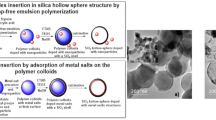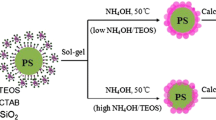Abstract
Silica hollow microspheres containing phosphorous have been prepared by a sol-gel/emulsion method which uses tetraethoxysilane (TEOS) as the precursor for the SiO2 and phosphoric acid (H3PO4) as the precursor for P2O5. The hollow structure forms an emulsion system which is composed of an oil phase (kerosene, sorbitan monooleate (Span 80)) and an aqueous phase (a viscous sol solution of ethanol, TEOS and H3PO4). Some of the phosphorous remains in the final silica shell structure even after calcination at 650°C. The hollow structure of the P2O5-SiO2 (silicophosphate) was characterized by X-ray diffraction (XRD), polarized optical microscopy (POM), scanning electron microscopy (SEM), nitrogen adsorption measurement and Fourier transform infrared spectroscopy (FTIR).
Similar content being viewed by others
References
Tung S P, Hwang B J. High proton conductive glass electrolyte synthesized by an accelerated sol-gel process with water/vapor management. Journal of Membrane Science, 2004, 241(2): 315–323
Tsvetkova I N, Shilova O A, Voronkov M G, Gomza Y P, Sukhoy K M. Sol-gel synthesis and investigation of proton-conducting hybrid organic-inorganic silicophosphate materials. Glass Physics and Chemistry, 2008, 34(1): 68–76
Uma T, Nogami M. Synthesis and characterization of P2O5-SiO2-X (X = aphosphotungstic acid) glasses as electrolyte for low temperature H2/O2 fuel cell application. Journal of Membrane Science, 2006, 280(1–2): 744–751
Hench L L. Bioceramics: from concept to clinic. Journal of the American Ceramic Society, 1991, 74(7): 1487–1510
Federman S R, Costa V C, Vasconcelos D C L, Vasconcelos W L. Sol-Gel SiO2-CaO-P2O5 biofilm with surface engineered for medical application. Materials Research, 2007, 10(2): 177–181
Pope E J A, Mackenzie J D. Sol-gel processing of silica: II. The role of the catalyst. Journal of Non-Crystalline Solids, 1986, 87(1–2): 185–198
Vasiliu I, Gartner M, Anastasescu M, Todan L, Predoana L, Elisa M, Negrila C, Ungureanu F, Logofatu C, Moldovan A, Birjega R, Zaharescu M. Structural and optical properties of the SiO2-P2O5 films obtained by sol-gel method. Thin Solid Films, 2007, 515(16): 6601–6605
Fernández-Lorenzo C, Esquivias L, Barboux P, Maquet J, Taulelle F. Sol-gel synthesis of SiO2-P2O5 glasses. Journal of Non-Crystalline Solids, 1994, 176(2–3): 189–199
Massiot Ph, Centeno M A, Carrizosa I, Odriozola J A. Thermal evolution of sol-gel-obtained phosphosilicate solids (SiPO). Journal of Non-Crystalline Solids, 2001, 292(1–3): 158–166
Maki Y, Sato K, Isobe A, Iwasa N, Fujita S, Shimokawabe M, Takezawa N. Structures of H3PO4/SiO2 catalysts and catalytic performance in the hydration of ethene. Appl Catal A: General, 1998, 170(2): 269–275
Elisa M, Sava B A, Volceanov A, Monteiro R C C, Alves E, Franco N, Costa Oliveira F A Fernandes H Ferro M C. Structural and thermal characterization of SiO2-P2O5 sol-gel powders upon annealing at high temperatures. Journal of Non-Crystalline Solids, 2010, 356(9–10): 495–501
Kang E S, Takahashi M, Tokuda Y, Yoko T. Template-free magnesium oxide hollow sphere inclusion in organic-inorganic hybrid films via sol-gel reaction. Langmuir, 2006, 22(12): 5220–5223
Huang J, Xie Y, Li B, Liu Y, Qian Y, Zhang S. In-situ sourcetemplate-interface reaction route to semiconductor CdS submicrometer hollow sphere. Advanced Materials (Deerfield Beach, Fla.), 2000, 12(11): 808–811
Lin H P, Liu S B, Mou C Y, Tang C Y. Hollow spheres of MCM-41 aluminosilicate with pinholes. Chemical Communications (Cambridge), 2001, 19(19): 1970–1971
Biggs S, Sakai K, Addison T, Schmid A, Armes S P, Vamvakaki M, Bütün V, Webber G. Layer-by-layer formation of smart particle coatings using oppositely charged block copolymer micelles. Advanced Materials (Deerfield Beach, Fla.), 2007, 19(2): 247–250
Shchukin D G, Gorin D A, Möhwald H. Ultrasonically induced opening of polyelectrolyte microcontainers. Langmuir, 2006, 22 (17): 7400–7404
Dai Z, Zhang J, Bao J, Huang X, Mo X. Facile synthesis of high-quality nano-sized CdS hollow spheres and their application in electrogenerated chemiluminescence sensing. Journal of Materials Chemistry, 2007, 17(11): 1087–1093
Massiot Ph, Centeno M A, Gouriou M, Domínguez M I, Odriozola J A. Sol-gel obtained silicophosphates as materials to retain caesium at high temperatures. Journal of Materials Chemistry, 2003, 13: 67–74
Author information
Authors and Affiliations
Corresponding author
Rights and permissions
About this article
Cite this article
Li, W., Xie, F., Hua, D. et al. Preparation of P2O5-SiO2 hollow microspheres in the presence of phosphoric acid. Front. Chem. Sci. Eng. 5, 314–317 (2011). https://doi.org/10.1007/s11705-010-0573-y
Received:
Accepted:
Published:
Issue Date:
DOI: https://doi.org/10.1007/s11705-010-0573-y




